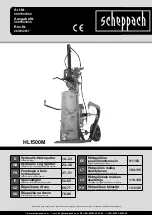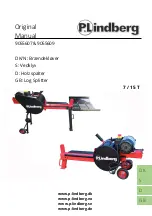
www.scheppach.com /
+(49)-08223-4002-99 /
+(49)-08223-4002-58
GB | 27
13. Transport
Move the splitter to the transport position beforehand.
See item 9.2, proceed in reverse order.
The log splitter is equipped with two transport wheels
and an additional transport wheel. Use the transport
handle (5) to move the splitter.
14. Storage
Store the device and its accessories in a dark, dry
and frost-proof place that is inaccessible to children.
The optimum storage temperature is between 5 and
30˚C.
Cover the electrical tool in order to protect it from
dust and moisture.
Store the operating manual with the electrical tool.
15. Maintenance
Attention!
Pull out the power plug before carrying out any main
-
tenance work on the equipment. Make sure that the
drive shaft is not connected to the traction unit.
When must the oil be changed?
First oil change after 50 operating hours, then every
250 operating hours.
Oil change (Fig. 14)
Bring the splitter to the transport position by tilting it
onto the transport wheels.
Place a sufficiently large
container (at least 7.5 litres) under the drain plug on
the splitting column.
Open the drain plug (d) and carefully let the oil run
into the container.
Open the filling screw (c) on the top of the splitting
column so the oil can drain more easily.
Replace the drain plug and its seal and tighten it.
Pour in fresh hydraulic oil (Contents: see Technical
data) and check the oil level with the dipstick. After
changing the oil, operate the kindling splitter a few
times without actually splitting.
Warning! Ensure that no debris gets into the oil
container.
Dispose of the used oil in a correct manner at a
public collection facility. It is prohibited to drop
old oil on the ground or to mix it with waste.
We recommend oil from the HLP 32 range.
Hydraulic system
The hydraulic unit is a closed system with oil tank, oil
pump and control valve.
Damaged electrical connection cable
The insulation on electrical connection cables is of-
ten damaged.
This may have the following causes:
• Passage points, where connection cables are
passed through windows or doors.
• Kinks where the connection cable has been im-
properly fastened or routed.
• Places where the connection cables have been cut
due to being driven over.
• Insulation damage due to being ripped out of the
wall outlet.
• Cracks due to the insulation ageing.
Such damaged electrical connection cables must not
be used and are life-threatening due to the insula-
tion damage.
Check the electrical connection cables for damage
regularly. Make sure that the connection cable does
not hang on the power network during the inspection.
Electrical connection cables must comply with the
applicable VDE and DIN provisions. Only use con
-
nection cables with the marking „
H07RN“.
The printing of the type designation on the connec
-
tion cable is mandatory.
For single-phase AC motors, we recommend a fuse
rating of 16A (C) or 16A (K) for machines with a high
starting current (starting from 3000 watts)!
Three-phase motor 400 V~ / 50 Hz
Mains voltage 400 V~ / 50 Hz
Mains voltage and extension cables must be 5-lead
(3P + N + SL (3/N/PE).
Extension cables up tp 25m long must have a mini-
mum cross-section of 1.5 mm².
Mains fuse protection is 16 A maximum.
When connecting to the mains or relocating the ma
-
chine, check the direction of rotation (swap polarity in
the wall socket if necessary). Turn pole inverter in the
machine socket.
12. Cleaning
Attention!
Pull out the power plug before carrying out any clean
-
ing work on the equipment.
We recommend that you clean the equipment imme
-
diately after you use it.
Clean the equipment regularly with a damp cloth and
some soft soap. Do not use cleaning agents or sol-
vents; these may be aggressive to the plastic parts in
the equipment. Ensure that no water can get into the
interior of the equipment.








































